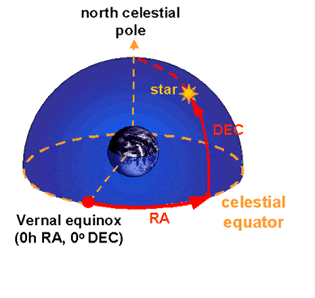Declination
Along with the right ascension (RA) and epoch, the ‘declination’ (Dec) of an object is used to define its position on the celestial sphere in the equatorial coordinate system.
Measured in degrees, arcminutes and arcseconds it defines how far north (positive Dec) or south (negative Dec) of the celestial equator the object lies, and is directly analogous to the latitude coordinate here on Earth. Stars on the celestial equator have Dec=0o, stars at the south celestial pole have Dec=-90o, and stars at the north celestial pole have Dec=+90o.

The declination coordinate is directly analogous to latitude here on Earth.
|

The declination of an object indicates how far north or south of the celestial equator it lies.
|
Adding in the RA and epoch, the coordinates of a typical star may look something like: 12:52:03.32, -47:34:43.0, J2000.0. In other words in the year 2000.0, the star had an RA of 12 hours 52 minutes and 3.32 seconds, and a Dec of 47 degrees 34 arcminutes 43 arcseconds south of the celestial equator.
Study Astronomy Online at Swinburne University
All material is © Swinburne University of Technology except where indicated.

